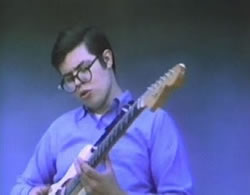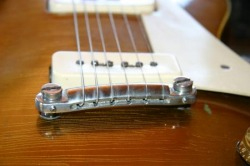Guitar
Alan Wilson: The Blind Owl’s Tone
By Bob Walters
Alan Wilson’s tone was just as important as the way he presented and played his music. It was carefully planned, and his choice of electric guitars was also just as important for creating the tone he wanted. It was effective, efficient, and he added no more and no less embellishment to his music. During Alan’s time with Canned Heat, he used a variety of guitars. In particular, the electric guitars used included a 60s white Fender Mustang, a late 60s blond Fender Telecaster, a late 60s cherry Gibson ES 335, and his mainstay, a Gibson 1954 Les Paul gold top.
The Mustang was used during Canned Heat’s performance at the 1967 Monterey Pop Festival. It is unknown if Alan actually owned this guitar, but based on how well he played it, and how comfortable he was, it is quite possible he owned it. The Telecaster was used during promotional and mimic performances as guests on various local and European television dance shows. This was  a typical format used by many television networks to attract the younger audiences such as American Bandstand. Alan’s use of the Telecaster only during the filming suggests he did not own this guitar and it may have been provided as a prop. The ES 335 was used and actually played live during Canned Heat’s 2nd appearance on the Playboy After Dark Show, approximately on January 27, 1970.It is also unknown if Alan owned this guitar.
a typical format used by many television networks to attract the younger audiences such as American Bandstand. Alan’s use of the Telecaster only during the filming suggests he did not own this guitar and it may have been provided as a prop. The ES 335 was used and actually played live during Canned Heat’s 2nd appearance on the Playboy After Dark Show, approximately on January 27, 1970.It is also unknown if Alan owned this guitar.
Alan’s main choice and probably the only electric he owned was his 1954 Les Paul. This was an interesting choice due to several reasons. His guitar was not a factory stock model, but had the potential to be what he wanted. The 54 model, did not as play well as later models of the time since the period stock tuning keys did not keep the instrument in tune as well as later, sealed worm gear type Grover tuners.
The stock tuners on Alan’s guitar were replaced sometime prior to Woodstock with modern Grover tuners. In addition the pick guard and bracket were also removed to provide room for Alan’s finger picking style. As with his modified harmonicas, both of these modifications made his guitar a more playable instrument to suit his particular needs. Vintage purists today would scoff at any attempts to upgrade a guitar such as this, but Alan wanted a playable instrument, not a showpiece.
The 54 model had a combination bridge / stop tail piece that provided both string support and intonation in one unit. It also featured P-90 single coil pickups. Both of these features were keys to Alan’s tone. Although Alan could have afforded or even borrowed any  guitar he wanted, he chose the 54 Les Paul for the following reasons. The P-90s have a construction whereby multiple windings are wound around a magnet to form a large single coil. The result is a pure tone but is susceptible to outside noise or interference. It can also distort the tone slightly if played or strummed hard. On the other hand, humbucker pickups have a construction whereby two coils are wound in opposite directions of each other and the magnets of each pickup have opposite polarity. Both pickups are then connected together in series. This construction then allows all common mode signals (noise) to be cancelled out. However a side effect is that some of the signal, (music) is also lost due to phase cancellation in the pickup. This results in a quieter, more powerful signal with less music spectrum than a single coil. Alan’s preference was clearly a single coil pickup vs. a humbucker.
guitar he wanted, he chose the 54 Les Paul for the following reasons. The P-90s have a construction whereby multiple windings are wound around a magnet to form a large single coil. The result is a pure tone but is susceptible to outside noise or interference. It can also distort the tone slightly if played or strummed hard. On the other hand, humbucker pickups have a construction whereby two coils are wound in opposite directions of each other and the magnets of each pickup have opposite polarity. Both pickups are then connected together in series. This construction then allows all common mode signals (noise) to be cancelled out. However a side effect is that some of the signal, (music) is also lost due to phase cancellation in the pickup. This results in a quieter, more powerful signal with less music spectrum than a single coil. Alan’s preference was clearly a single coil pickup vs. a humbucker.
The combination of a bridge / stop tail piece attracted Alan as well. The strings were required to run through the bridge toward the bottom of the guitar, then wrap around over the top of the bridge and onto the fret board. This resulted in better mechanical coupling of the strings to the body and increased sustain. The downside to this design is that intonation was less than perfect and was compensated using the string height adjustment screws, and the rear mounted set screws.

This less than perfect bridge design did not hinder or affect Alan’s tone, in fact it enhanced it. The over the top bridge design placed the strings directly on top of the wider bridge surface area, and over a short period of time, since the bridge was a softer metal, the strings would wear grooves into the bridge, and cause oxidation. It is this wear that would give the strings a slightly longer ring /buzz, when played on this particular bridge design. This sound appealed very much to Alan as it was similar to a damped tamboura or sitar.
Listed here are examples of Alan’s tone. Please visit the following links:
1.Whiskey Headed Woman II. In the beginning riff, you can hear Alan’s guitar and the distinctive buzz / sustain of his guitar.
2. Woodstock Boogie. This live clip taken during the famous, 3 day 1969 Woodstock Festival features great close-ups of Alan’s guitar, and his technique for creating his distinctive tone filled with harmonics.Alan’s intro illustrates several examples of the distinctive buzz / sustain of his notes unique to this 54 Les Paul. In this clip you can also hear how the tone is purposely driven into distortion by strumming the guitar harder. Wonderful harmonics and overtones are created when Alan does this. Watch and listen how he starts the boogie at 1:25. This is another example of Alan’s simple yet effective genius using drone techniques to create the Boogie.
3. On The Road Again. In addition to other instruments on this studio recording, Alan was featured playing a multi-tracked tambora, to give a spatial sustaining drone tone similar to Indian music. Notice how this tune has similar drone and sustaining traits compared to the other recordings. In this clip the original studio recording is played while Canned Heat mimics their recording. Another example of a guest band on a television network format. http://www.youtube.com/watch?v=QexOuH8GS-Y
4. London Blues. This first example is from the Future Blues album, where Alan creates a full sustaining ring. http://www.youtube.com/watch?v=Kdx5E7GmG8w
This second example is taken from a live performance, where Alan is playing his 54 Les Paul. Although Alan rarely used any effects during live performances, here he is using a tremolo effect to further give his tone a convincing tambora tone.